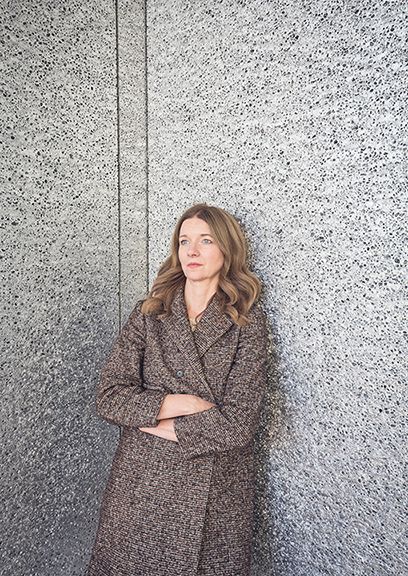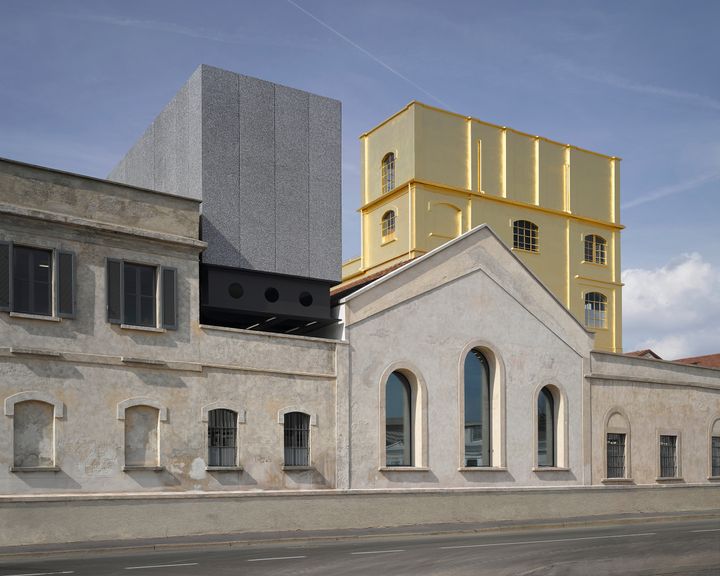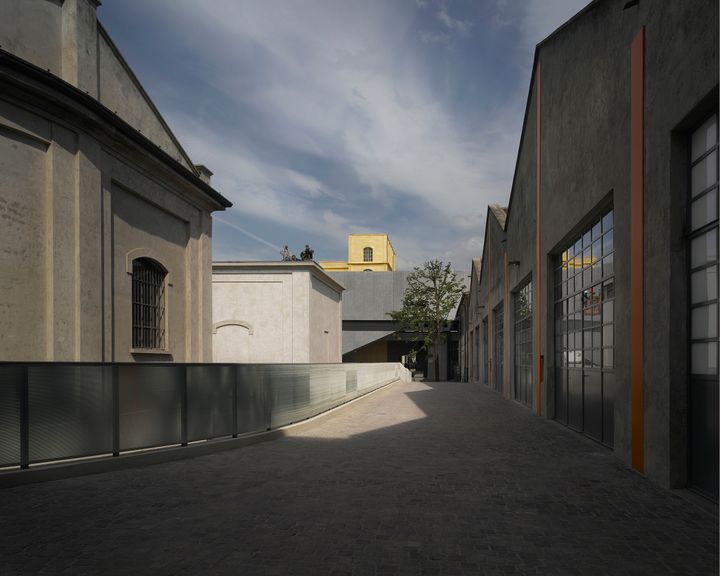
Astrid Welter
Fondazione Prada was established in 1993. At the core of the Fondazione is the idea that culture is deeply useful and necessary and that it should help us understanding how the world and we are changing.
Fondazione Prada’s art complex is located in the south of Milan, on the site of an old distillery dating back to the 1910’s. It includes nine buildings, both new and old. Fondazione Prada has two additional venues. Ca’Corner della Regina, a Venetian palazzo that hosts exhibitions and Osservatorio, a new exhibition space dedicated to photography located in downtown Milan. During our recent conversation at Fondazione Prada in Milan, Astrid Welter, the Head of Programs at Fondazione Prada spoke passionately about the mission, the institutional structure, and the programs of Fondazione Prada.
Lilia Ziamou: How would you describe the mission of Fondazione Prada and how has it evolved over time?
Astrid Welter: Fondazione Prada was established in 1993. It was based on Mrs. Prada and her husband’s Mr. Bertelli’s, personal curiosity, passion and interests. In the early '90s, there were not as many foundations as there are today. Mrs. Prada and Mr. Bertelli were interested in establishing a cultural institution separate from the business of the brand and with its own purpose. Both Mrs. Prada and Mr. Bertelli have always been deeply interested in theater, cinema, music, literature, philosophy. Their interest in art emerged later on, but then became a big passion.
Contemporary art was probably the original DNA of the Fondazione Prada. From 1993 to 2011, the Fondazione was inviting artists to Milan to work on new projects in collaboration with us. The Fondazione was a place where we would work with artists over a period of years to encourage research and to make it possible for them to produce their work. This was possible for three reasons. First, we had the big warehouse spaces. Second, we enabled artists to meet and collaborate with engineers and scientists to realize their projects. Lastly, we could finance the projects. The opening of a permanent cultural complex in Milan in has offered new opportunities to enrich our processes of learning. There is a growing interest, for example, in cinema and the performing arts. We have an unusual art complex that comprises nine buildings, small, big, old and new. And since last December we have the Osservatorio, a new space in downtown Milan.
Fondazione Prada is an institution about culture. Our central question is “What is a cultural institution for?” We may not have a complete answer. But we want to define ourselves as an institution that is trying to understand what the purpose of a cultural institution is today. We believe that culture is deeply useful and necessary as well as attractive and engaging. We also believe that culture should help us with our everyday lives and our understanding of how we, and the world, are changing.
Lilia Ziamou: Tells us about the relationship between Fondazione Prada and Collezione Prada.
Astrid Welter: Collezione Prada was pre-existing of the foundation. Since the beginning, Mrs. Prada and Mr. Bertelli decided that the Fondazione should be a separate entity, run by art professionals and not linked to the fashion business. We develop exhibitions that are based on the collection but we are not interested in just showing the collection. Our goal is to generate interesting themes from the collection, to conceive the collection as a resource of perspectives and potential energy. We are interested in integrating and sharing various perspectives and approaches in our inquiry about what we can take out of the collection, what are the ways to share it.
For example, Trittico (2015) was an exhibition conceived by the Thought Council, a curatorial team whose members hail from different fields in the arts and culture, and who were invited by Fondazione Prada to elaborate on various ideas and projects. The display system for Trittico developed around the idea that our experience of a work of art is understood through other works of art and that the Collezione Prada contains multiple interpretation.
Another example is Atlas, a series of exhibitions that will be developed over time and aims to highlight the possible mappings of the art collection. It is a form of investigation made from the inside of the collection. We hope that the name conveys the idea of exploration, similar to the one we have when looking at a map. Atlas I (2017), the first exhibition in this series focuses on the 1990s and includes works that are the outcome of a process of planning.

Fondazione Prada
Lilia Ziamou: You have an interesting institutional structure that ‘aims towards reinvention’. Tell us about this open structure. How does it work?
Astrid Welter: Fondazione Prada is not a museum. It is an institution about culture and as a result it required a non-traditional institutional structure. We maintain an open structure where ideas are freely exchanged between the Fondazione Prada’s Presidents, Mrs. Prada and Mr. Bertelli, Germano Celant, the Artistic and Scientific Superintendent, the Fondazione’s curatorial department and the Thought Council. The curatorial department is a team of three, myself as Head of Programs, Mario Mainetti, Head of Research and Publications, and Alessia Salerno, Head of Exhibition Design and Production. The Thought Council is a group of individuals invited to think and work with us for different durations of time. It is not a group of curatorial advisors. Thought Council members are deeply engaged, meet and work with us, and generate collective outputs. We are all trying to develop meaningful programs for the long term.
Lilia Ziamou: Tell us about the two permanent projects at the Fondazione Prada. Robert Gober / Louise Bourgeois at the Haunted House and Thomas Demand: Processo Grottesco. How did these come about?
Astrid Welter: The Haunted House at the Fondazione Prada art complex is a very special building. The exterior of the 4-story building dating from the early 20th century has been has been gilded in gold leaf. It is comprised of a sequence of single rooms that create an intimate space. There is a permanent installation by Louise Bourgeois who had a close relationship with Mrs. Prada. They had shared interests in the concepts and representations of women and the body and Mrs. Prada cherished their friendship. We had an exhibition of Louise Bourgeois’ work in 1997 and there was always a desire to find a place for two of her works that were developed for this exhibition: Cell and Single III. The Haunted House has a more domestic scale. There was also an existing ongoing friendship between Mrs. Prada and Robert Gober. When Robert Gober saw the Haunted House he fell in love with it. He knew Louise Bourgeois and they had a lot in common. So, there is a permanent installation of Gober’s works in the higher floors of the building. This is how the Haunted House came about.
Processo Grottesco, Thomas Demand’s permanent installation is on the underground level of Fondazione Prada’s Cinema. The installation is from our exhibition with Demand in Venice in 2007. Thomas Demand is, of course, a well-known photographer. He's known for his work, but people don’t know how he got there. Where does his art come from? The work he showed in Venice was the representation of a cave in Majorca. For this project, using virtual computer technology, he reconstructed the grotto in cardboard. It was huge and required 30 tons of grey cardboard. So, in this project, the use of technology makes it possible to imitate natural stratifications that were developed incredibly slowly over a long period of time. The installation reflects the artist’s interest in what reality is and in the reconstruction of reality.

Fondazione Prada
Lilia Ziamou: Concluding thoughts about Fondazione Prada’s future plans?
Astrid Welter: In the upcoming months, Fondazione Prada will develop a multidisciplinary program that includes retrospectives and solo shows devoted to prominent artistic movements and figures of the recent past, film festivals, a site-specific intervention by the Austrian collective Gelitin, and new photographic exhibitions for the Osservatorio outpost. We are interested in continuing to explore new grounds of research in various fields. Our experimental vocation and long-lasting engagement towards the correlation between different languages has been recently embodied by Alejandro G. Iñárritu’s VR installation CARNE y ARENA, on view in Milan until January 15, 2018.
The transcribed text has been edited for length and clarity.
Lilia Ziamou is a visual artist. www.lilia-artspace.com
